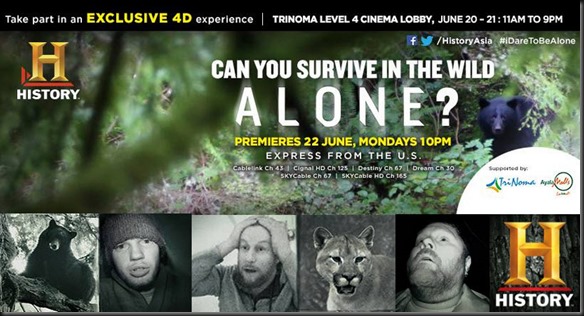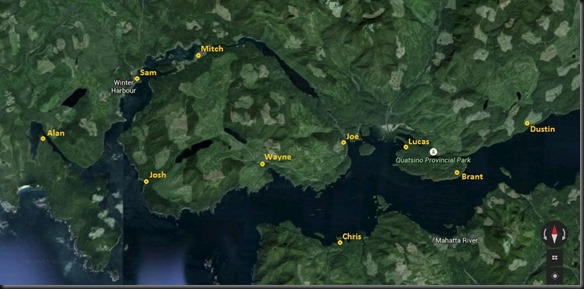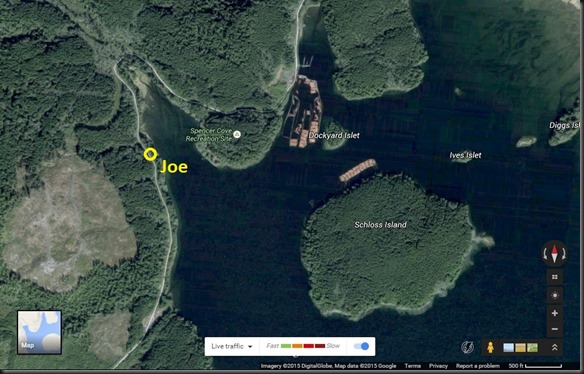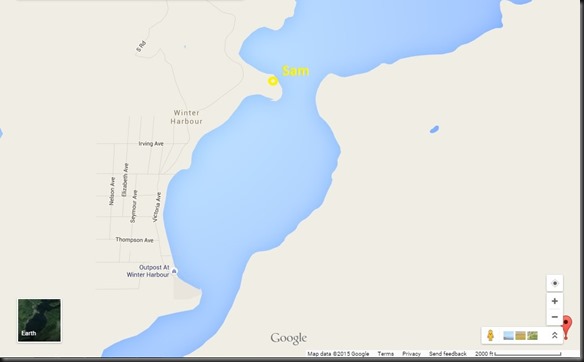You guys have probably noticed that I have said very little about the popular History Channel show Alone. For those of you not familiar at all, the premise of the show is that several people are dropped off in the “wilderness” with a limited amount of gear and are left to survive there for up to a year. The one who lasts out the longest wins $500,000.
There are two reasons why I haven’t posted much about the show. The first is that I think all of the contestants deserve some degree of respect. Granted, some were not able to last even a handful of days, but just being willing to put your life on hold for an extended period of time just so you can test yourself is quite something. These guys are amateurs, and as such have made a sacrifice to be on the show. Now, it seems a few of them are now trying to push their own survival/bushcradft schools, which will of course bring a higher level of scrutiny and expectations; but that’s for another post. The second reasons is that I am not a fan of Monday morning quarterbacking. Things are just different on the ground. Many things look like a good idea when you are in the woods, that seem silly when watching it at home, and the other way around. On top of that, all this footage is heavily edited, making it hard to know exactly what happened. So, in this post, I will try to keep such comments to a minimum.
The reason I decided to write this post is because of the huge number of emails I have received asking me to comment on the show. In particular I have received a number telling me how the show represents true bushcraft, or real survival, etc. Many people I have spoken to have what I believe to be very misguided ideas about what the show actually is or what happened during its course. In some respects Alone is a very “real” show, in others it’s nothing of the sort. If you haven’t been dealing with production companies for some time, it may be hard to tell which is which. So, here is my attempt to draw some distinctions:
What Was Not So Real:
Stranded in the wilderness: location, location, location
The first thing that caught my attention a while back was the location of the show. We all know it’s Vancouver Island, and most people assume that the contestants were dropped off in some sort of untouched wilderness. Well, based on an early map shown by the History Channel, and based on the research of a few guys, it appears the exact location is near Winter Harbor on Vancouver Island, approximate GPS coordinates of 50.5057662,-127.9784363. Now, here is what that gives us when plotted on top of the satellite view of the area:
The above map is small, but even from that picture your eye is probably detecting large clearings and roads right next to the contestants. Here is a closer view of Mitch’s location:
Here is a closer view of Joe’s location:
Here is a street view of Sam’s location:
These locations are approximate, but based on the map from the History Channel, they should be fairly accurate. You can do your own search on Google Maps Satellite View or Google Earth using the above coordinates.
Is that what you had in mind when you were watching the show? Did you know that every one of the contestants was less than an hour’s walk from a road, town, or clearing? Did you know that some of them were in actual campsites?
Now, to be fair, these are logging areas and logging roads. They don’t exactly see a lot of traffic and were probably not in use at the time of filming. Even so though, did you see any of that on the show? Did any of the contestant hunt the edges of the clearings or roads? Did any of them go into town for a beer?
When I first discovered this, I figured that is the reason why none of them moved about much. Walking in any direction for about an hour would have taken them into a clearing or a road. I though that, until I saw their gear lists. Then I decided that the reason they couldn’t move about was because they couldn’t move the huge amount of gear they had.
Gear, gear everywhere
So, the premise of the show was that these guys could only bring ten items with which to survive. They could chose these ten items from a list of 40 items that was provided to them. On its face it may seem like a challenging task. Well, the History Channel released the gear lists. You can look for yourself here. Here is a brief summary:
Items that were carried that did NOT count in the ten items (I have removed the filming items from the lists, i.e. cameras, etc):
- 1 canister wild animal repellant
1 air horn
1 backpack
1 emergency flare
1 satellite phone
1 emergency personal flotation device
1 first aid kit (military type – tourniquet, wadding, ace bandage, alcohol, plastic bag, etc)
1 small mirror
1 20×20 canvas tarp
1 10×10 canvas tarp for camera gear
1 head lamp
1 gps tracking device
1 emergency rations pack to include water and food - 1 woolen sweater
1 pair of gloves
1 trapper’s hat with ear protection or toboggan - 1 pair high leg Hunting boots
2 pairs of Outdoor Pants (can unzip into shorts)
1 t-shirt
2 fleece or wool shirts (a hooded fleece is approved)
3 pairs wool socks
1 hat (brimmed, wool or baseball)
1 bandana or shemagh
1 pair gloves
1 light outdoor jacket
2 pairs underwear
1 rain jacket and rain trousers
1 thermal underwear (long)
1 pair of gaiters
1 pair of Crocs, Teva sandals or Keen sandals
1 toothbrush
1 pair of prescription eye glasses
1 personal photograph
And, we still haven’t gotten to the ten (10) items. None of the above gear counts towards the ten items. Now, here is the gear list from which the contestants could pick their ten (10) items:
- 12×12 ground cloth/tarp (grommets approved)
8 mm climbing rope
550 parachord – 20m
1 hatchet
1 saw
1 axe - 1 multi-seasonal sleeping bag that fits within provided back-pack
1 bivi bag (gortex sleeping bag cover)
1 sleeping Pad
1 hammock - 1 large (no more than 2 quart) Pot, includes lid
1 steel frying pan
1 flint or ferro rod set
1 enamel bowl for eating from
1 spoon
1 disposable lighter
1 canteen or water bottle
1 bear canister - 1 bar soap
1 8 oz tube of toothpaste
1 face flannel
1 40 m. roll dental floss
1 small bottle bio shower soap
1 shaving razor (and 1 blade)
1 towel (30” x 60”)
1 comb - 1 300 yard roll of nylon single filament fishing line and 25 assorted hooks (No lures)
1 primitive bow with 6 Arrows (must be predominately made of wood)
1 small gauge gill net (1.5 m deep x 6 m long and 2 inch [50 mm] mesh)
1 slingshot/Catapult
1 net foraging bag
3.5 lb roll of trapping wire - 5 lbs of beef jerky (protein)
5 lbs of dried pulses/legumes/lentils mix (starch and carbs)
5 lbs of biltong (protein)
5 lbs of hard tack military biscuits (carbs/sugars)
5 lbs of chocolate (Simple/complex sugars)
5 lbs of pemmican (traditional trail food made from fat and proteins)
5 lbs of gorp (raisins, m&m’s and peanuts)
5 lbs of flour. (starch/carbs)
2 lbs of rice or sugar and 1 lb of salt - 1 pocket knife
1 hunting knife
1 leatherman multi-tool
1 sharpening stone
1 roll of duct tape or 1 roll of electrical tape
1 small shovel
1 small sewing kit
1 carabineer
1 LED flashlight
1 pair of ice spikes
Now, for someone who doesn’t spend a lot of time in the woods, the above list may not seem like anything special. For those however, who do backpack, camp, hunt, or otherwise spend time in the woods, it is clear that the contestants had a huge amount of very useful gear. In fact, what was depicted as a survival challenge on TV, was a well equipped camping trip. The only true survival element of the show, the lack of food, seems to have been completely self inflicted by overconfident contestants. Let’s dive into it a bit deeper.
Let’s look at a standard camping set up that can be put together from the above list:
- 20x20 tarp (didn’t count towards the ten (10) items). It should be noted that 20x20 is a huge tarp. For most campers and backpackers a 10x10 tarp is considered large.
- A four season sleeping bag
- A sleeping pad
- A backpack (didn’t count towards the ten (10) items)
- A 2qt pot
- A lighter/ferro rod. Considering the trouble all of the contestants had starting a fire with their ferro rods, a lighter might have been a good choice.
- A head lamp (didn’t count towards the ten (10) items)
- An axe
- All the clothing you could ever want (didn’t count towards the ten (10) items)
- A bag of food (didn’t count towards the ten (10) items)
- A mirror (didn’t count towards the ten (10) items)
- A first aid kit (didn’t count towards the ten (10) items)
- A toothbrush (didn’t count towards the ten (10) items)
- A bandana (didn’t count towards the ten (10) items)
So, the above list is pretty much a complete backpacking/camping set up. It’s approximately the amount of gear I carry when I go on any trip into the woods, and provides for a comfortable and pretty ordinary camp.
I have managed to put together the above list and have only used five (5) items from the forty (40) items list. Realistically, since you have an axe, and don’t plan on traveling, the sleeping pad is not needed, which will bring you down to four (4) items from the list. So, that will leave us with six (6) more items to chose for our ten (10) items list.
Considering that the winning contestant won by lasting just under two months, a smart choice might have been to bring extra food. The provisions list had some excellent choices. Here is what I would have picked:
- 5 lbs of biltong (protein)
- 5 lbs of hard tack military biscuits (carbs/sugars)
- 5 lbs of chocolate (Simple/complex sugars)
- 5 lbs of pemmican (traditional trail food made from fat and proteins)
- 5 lbs of gorp (raisins, m&m’s and peanuts)
- 5 lbs of flour. (starch/carbs)
The above food would have allowed one to comfortably stay in the woods for months. If you rationed out the food even slightly, a contestant could have spent many months in the woods without ever trying to look for food. Keep in mind that this food is on top of the food that was already provided to them that didn’t count towards the ten (10) items. Update (9/16/15): A comment was just posted by Stefany Kay, who represents to be a wife of one of the contestants, and ha provided some additional information. According to her, the contestants could only pick one food item from the category. That would have leveled the playing field much faster. 5lb of pemmican can be stretched out to about two weeks, but not much longer. After that all of the contestants would have been in the category of “a camping trip without food”. I have no way of independently confirming the information, and the History Channel hasn’t published that limitation, but it would make sense.
Now, realistically, thinking even longer term, I would have replaced one of the food items with the fishing kit.
Personal choices aside however, this was a camping trip in a wilderness area what wasn’t exactly as wild as we were lead to believe. Add to that some other minor things like the fact that the contestants weren’t in complete isolation. They were regularly visited by medical crews, especially towards the end when they were literally starving to death. Some parts were also reenacted for the camera, etc.
What Was Real:
The above aside, some aspects of the show were quite real.
Experience at individual wilderness skills does not equal wilderness experience
The first aspect that was very real is that it clearly demonstrated the difference between backyard bushcraft/survival vs. actually having experience in the woods. Now, I know “backyard bushcraft” has a negative connotation, and my intent is not to start a fight about it. The difference I am trying to point out here is that between being skilled at individual tasks that you practice in a controlled environment and actually spending time in the woods. There is a difference between being an expert at individual wilderness skills, and being a wilderness expert. While there is clear value to practicing skills in a controlled environment, such skills do not translate well into actually spending time in the woods. There are many people who are world famous experts at flint knapping, at friction fire lighting, etc, who have never spent a night in the woods. The difference is clear, it’s very real, and it was made obvious by the show.
Considering the above abundance of gear, the fact that so many contestants couldn’t last even a handful of days in the woods, on what was pretty much a camping trip, is mind blowing. It shows the reality of what it takes to spend prolonged amounts of time in the woods. These are people who considered themselves skilled at bushcraft and survival, who have YouTube channels, who want to open bushcraft schools, etc, yet they couldn’t do what any self respecting backpacker can accomplish without even a second thought.
Some of the things we saw early on were clear indication of people who had not spent any significant amount of time in the actual woods. Things like obsession with bears, or preoccupation with making fire when you have a seeping bag, a tarp, and all the fresh rain water you could drink, are indicators of lack of wilderness experience. For anyone who spends any time in the woods, having bears around you is a common occurrence, and so is staying out for prolonged periods of time without a fire. Now, these guys are actually very skilled at individual tasks. I have seen some of them show significant skill at making feathersticks, building fires, etc. However, that is not the same as having the experience of being in the woods.
Alone very clearly demonstrated that difference, and in that respect was a very real show. That aspect is often eliminated from other “survival” shows where you have large crews, set up challenges, and nights in the hotel room.
Not everything that is edible is food
The second aspect in which the show was very real was that of food procurement in a long term survival/bushcraft situation. As outlined above, each contestant had a full camping kit with them. Many of them also chose to bring hunting and fishing implements instead of extra food, presumably because they were confident in their ability to find food. As such, the main real survival/buschraft aspect here was the procurement of enough food to sustain one’s self long term. The only thing they had to do was find enough food. The show was very realistic in showing the difficulty of doing that.
According to People magazine, Alan, who won the show and arguably did the best at finding food sources, lost 60lb in the two months during which the show lasted. That is a clearly unsustainable rate of weight loss. Even if the rest of the contestants hadn’t tapped out by that point, I imagine the production company would have shut down the show because of the danger to the contestants. I am told medical teams were regularly checking the contestants especially towards the end. This type of starvation is dangerous and can not be maintained long term. In fact, they all seemed to have been on track to confirm the old saying that one can last three months without food. Add to that, from what I have been told, the contestants were on tribal land, which removed many of the hunting and fishing regulations and restrictions we have otherwise, although not all of them. I think this the actual restrictions on hunting and trapping are an important factor, that hasn’t been released by the History Channel.
The fact that all of the contestants had such a hard time finding anywhere near the necessary amount of food, even though they had few other concerns, considering that they had large amounts of camp gear to provide for their other needs, is a very real aspect of the show. I think people often overestimate their ability to find sufficient calories when in the woods, and they certainly underestimate the amount of calories one needs.
So, How Real Was It?
So, how real of a survival show was Alone? I think the answer is somewhat, but less than most people think.
The location certainly wasn’t what many of us imagined, with easy access to roads, clearings, established camp sites, a town, etc. All of the contestants also had complete camping set ups, eliminating any “survival” challenge other than possibly procuring food. A smart contestant also had the ability to bring 30lb of calorie dense food, which could have comfortably lasted them several months while they napped under a tarp in their sleeping bag. In many respects this was a camping trip in an area that has seen noticeable use by people. For a contestant who chose to bring food, it would have been a very, very regular camping trip.
What was real was the litmus test provided by the woods. It is very different to practice a skill at home, and then translate all those skills to time spent in the woods. There are many backpackers who have no idea how to use an axe, make a feather stick, or make a fire with a ferro rod, but they routinely spend extended amounts of time in the woods. Here in many of the cases we saw the opposite, people who had individual wilderness skills that they had practiced in a controlled environment at home (in that I’m including the woods behind the home), but lacked the experience of actually being in the woods for significant periods of time. With the above gear, there is no reason why anyone should have tapped out within days other than lack of experience when it comes to actually being in the woods. I think the show showed that reality very well. It also clearly showed the difficulty of long term survival in terms of food procurement. It is just not as easy as people think. If things had continued they way they had been going, I don’t think any of the contestants would have made it past three months without serious damage to their bodies.
Personally, in terms of “realness” I would rank the show below Survivorman and Naked and Afraid, but above all the other survival garbage we see on TV these days. Les Stroud has been doing a similar thing, but I think he is a lot more honest about the production aspect of his show and why he is doing what he is doing.
Anyway, these are my thoughts on the show for those who were asking. Ultimately I was very disappointed when I discovered the information about the location and the gear list. I though I was watching a show that turned out to be something else entirely. With the amount of gear they had, I think it was less of a survival challenge, and more of a psychological endurance test.





No comments:
Post a Comment